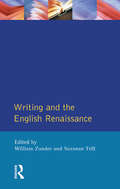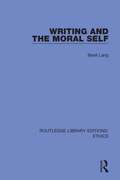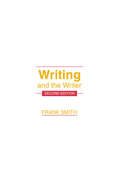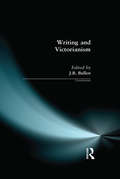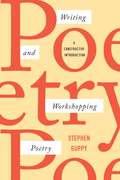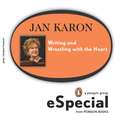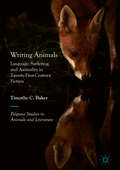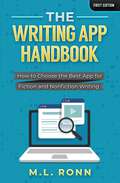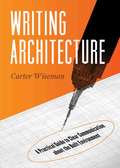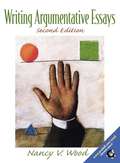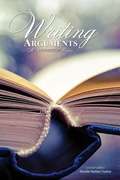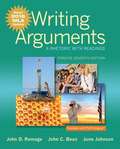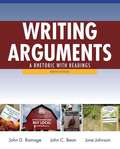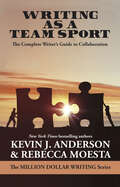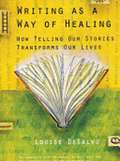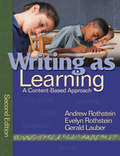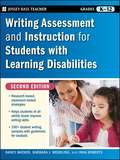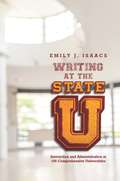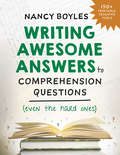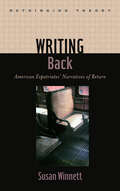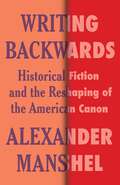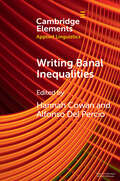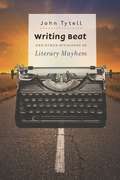- Table View
- List View
Writing and the English Renaissance (Crosscurrents)
by Suzanne Trill William ZunderWriting and the English Renaissance is a collection of essays exploring the full creative richness of Renaissance culture during the sixteenth and seventeenth centuries. As well as considering major literary figures such as Spenser, Marlowe, Donne and Milton, lesser known - especially women - writers are also examined. Radical writing and popular culture are considered as well. The scope of the study not only extends the parameters for debate in Renaissance studies, but also adopts a radical interdisciplinary approach, bridging the gap between literary, historical, cultural and women's studies, leading to a much fuller picture of life in the sixteenth and seventeenth centuries.The authors discussed are placed in their full historical and literary context, with an extensive selection of original documentation included in the text - for example, from The Book of Common Prayer or the Homilies to contextualize the writing under discussion. This distinctive approach, combined with a detailed chronology of the period and bibliography, embracing both canonical and non-canonical writers, makes this volume a unique reference resource and course reader for Renaissance studies.
Writing and the Moral Self
by Berel LangOriginally published in 1991, this book analyses the relation between writing and ethics in a number of social contexts – in politics, as language discloses its connections to the institutions of totalitarianism and democracy; in the university, as contemporary scholarly ideals find an uncomfortably accurate representation in the stylistic forms of academic writing; in daily social practice, ranging from the status of truth in journalistic writing to the connection between pronouns and affirmative action; and finally in the ethical structure of language itself.
Writing and the Writer
by Frank SmithExploring the relationship between the writer and what he/she happens to be writing, this text by one of the foremost scholars in the field of literacy and cognition is a unique and original examination of writing--as a craft and as a cognitive activity. The book is concerned with the physical activity of writing, the way the nervous system recruits the muscles to move the pen or manipulate the typewriter. It considers the necessary disciplines of writing, such as knowledge of the conventions of grammar, spelling, and punctuation. In particular, there is a concern with how the skills underlying all these aspects of writing are learned and orchestrated. This second edition includes many new insights from the author's significant experience and from recent research, providing a framework for thinking about the act of writing in both theoretical and practical ways. A completely new chapter on computers and writing is included, as well as more about the role of reading in learning to write, about learning to write at all ages, and about such controversial issues as whether and how genre theory should be taught. Written in nontechnical language, this text will continue to be accessible and stimulating to a wide range of readers concerned with writing, literacy, thinking, and education. Furthermore, it has an educational orientation, therefore proving relevant and useful to anyone who teaches about writing or endeavors to teach writing.
Writing and Victorianism (Crosscurrents)
by J. B. BullenWriting and Victorianism asks the fundamental question 'what is Victorianism?' and offers a number of answers taken from methods and approaches which have been developed over the last ten years. This collection of essays, written by both new and established scholars from Britain and the U.S.A, develops many of the themes of nineteenth-century studies which have lately come to the fore, touching upon issues such as drugs, class, power and gender. Some essays reflect the interaction of word and image in the nineteenth-century, and the notion of the city as spectacle; others look at Victorian science finding a connection between writing and the growth of psychology and psychiatry on the one hand and with the power of scientific materialism on the other.As well as key figures such as Dickens, Tennyson and Wilde, a host of new names are introduced including working-class writers attempting to define themselves and writers in the Periodical press who, once anonymous, exercised a great influence over Victorian politics, taste, and social ideals. From these observations there emerges a need for self-definition in Victorian writing. History, ancestry, and the past all play their part in figuring the present in the nineteenth-century, and many of these studies foreground the problem of literary, social, and psychological identity.
Writing And Workshopping Poetry: A Constructive Introduction
by Stephen GuppyMost texts on creative writing emphasize either sources of inspiration or strategies for editing. The process of getting from initial inspiration to final draft isn’t often dealt with in any practical way. Writing and Workshopping Poetry focuses on all three phases of the process of composition: finding the material; building and developing the poem from rough draft to complete work; editing and refining. The text offers everything students and instructors need: extensive notes written in an accessible, conversational style; seventy-five writing exercises; and about a hundred poems chosen from a wide range of sources, from sixteenth-century sonnets to experimental constrained forms, with an emphasis on exciting poems by contemporary American and Canadian poets. Each chapter concludes with a brief, point-form summary of major learning objectives as well as a review list of useful terms.
Writing and Wrestling with the Heart: Jan Karonfs Washington National Cathedral Lecture
by Jan KaronIn this Penguin eSpecial, Jan Karon, the bestselling author of the Mitford and Father Tim novels, tells the personal story of her life as a writer. Illuminating the way in which faith has influenced both her life and her writing, Karon also discusses her calling as an author--a calling she received early but took years to answer. Only an incredible leap of faith gave her the courage to give up all she had, risking everything to follow this call. Intimate, funny, and straight-from-the-heart, this eSpecial is a superb companion to Jan Karon's novels, providing a revealing glimpse into the life of a novelist who has moved so many people with her words.
Writing Animals: Language, Suffering, and Animality in Twenty-First-Century Fiction (Palgrave Studies in Animals and Literature)
by Timothy C. BakerThis book surveys a broad range of contemporary texts to show how representations of human-animal relations challenge the anthropocentric nature of fiction. By looking at the relation between language and suffering in twenty-first-century fiction and drawing on a wide range of theoretical approaches, Baker suggests new opportunities for exploring the centrality of nonhuman animals in recent fiction: writing animal lives leads to new narrative structures and forms of expression. These novels destabilise assumptions about the nature of pain and vulnerability, the burden of literary inheritance, the challenge of writing the Anthropocene, and the relation between text and image. Including both well-known authors and emerging talents, from J.M. Coetzee and Karen Joy Fowler to Sarah Hall, Alexis Wright, and Max Porter, and texts from experimental fiction to work for children, Writing Animals offers an original perspective on both contemporary fiction and the field of literary animal studies.
The Writing App Handbook: How to Choose the Best App for Fiction and Nonfiction Writing (Author Level Up #11)
by M.L. RonnHow's your writing app working out for you lately? If you're reading this, then you're dissatisfied with your current writing software and want something better. After all, your time is too valuable to waste fighting with an app that doesn't love you back. The RIGHT writing app will make you twice as productive and help you write more books in less time. You’ll be able to write more books than you ever dreamed of. In this guide, prolific author M.L. Ronn will cover the top features of the hottest writing apps on the market to help you choose the best fit for your writer personality. You'll discover: How the right writing app can boost your word counts and reduce typos in your books How to avoid wasting money on the wrong writing app (buy it nice or buy it twice!!) Apps that are better than OpenOffice, MS Word, and Google Docs: 100% guaranteed 35+ helpful features that writers are using to crush their novels A free tool that can help you pick the best writing app in a few clicks Don't settle for the wrong fit. Buy the Writing App Handbook to meet your perfect writing app today! V1.0
Writing Architecture
by Carter WisemanFor ages, architects have been criticized for speaking an insular language, known to some as "archispeak." Writing Architecture considers the process, methods, and value of architecture writing based on Carter Wiseman's 30 years of personal experience in writing, editing, and teaching in young architects how to write. This book creatively tackles a problematic issue that Wiseman considers to be a crucial characteristic of successful architecture writing: clarity of thinking and expression. He argues that because we live our lives within the built environment, architecture is the most comprehensive and complex of all art forms. Even brilliantly inspired and complex architectural structures would only amount to misunderstood abstractions without the support and reinforcement of the clear explanation.Written as a primer for both college level students and practitioners, Writing Architecture acknowledges and explores the boundaries between different techniques of architecture writing from myriad perspectives and purposes. A poetic description of the beauty and impact of a bridge will not illuminate the mechanical knowledge housed in the structure, but at the same time, dense architectural theory will not encourage individuals experiencing and supporting the bridge to perceive significance and usefulness in the design. Using excerpts and from writers in different genres and from different historical periods, Wiseman offers a unique and authoritative perspective on comprehensible writing skills needed for success.
Writing Architecture
by Carter WisemanFor ages, architects have been criticized for speaking an insular language, known to some as "archispeak." Writing Architecture considers the process, methods, and value of architecture writing based on Carter Wiseman's 30 years of personal experience in writing, editing, and teaching in young architects how to write. This book creatively tackles a problematic issue that Wiseman considers to be a crucial characteristic of successful architecture writing: clarity of thinking and expression. He argues that because we live our lives within the built environment, architecture is the most comprehensive and complex of all art forms. Even brilliantly inspired and complex architectural structures would only amount to misunderstood abstractions without the support and reinforcement of the clear explanation.Written as a primer for both college level students and practitioners, Writing Architecture acknowledges and explores the boundaries between different techniques of architecture writing from myriad perspectives and purposes. A poetic description of the beauty and impact of a bridge will not illuminate the mechanical knowledge housed in the structure, but at the same time, dense architectural theory will not encourage individuals experiencing and supporting the bridge to perceive significance and usefulness in the design. Using excerpts and from writers in different genres and from different historical periods, Wiseman offers a unique and authoritative perspective on comprehensible writing skills needed for success.
Writing Argumentative Essays (Second Edition)
by Nancy V. WoodThis unique rhetoric/reader helps readers develop strategies for critical reading, critical thinking, research, and writing that will help them argue clearly and convincingly in all types of argument. It shows how to identify and develop arguments, read and form reactions and opinions, analyze an audience, seek common ground, and use a wide, realistic range of techniques to write argument papers that express their individual views and original perspectives on modern issues. <P><P> Includes clear explanations and examples of argument theory and reading and writing processes, research and documentation skills, and offers a variety of writing activities for developing the exploratory paper, position paper, researched position paper, and the Rogerian argument paper. Unique chapters discuss argument styles (including cross-gender and cross-cultural communication styles), Rogerian argument, and argument and literature. 49 Essays for Analysis (several in each chapter) cover several broad issue areas and sub-issues concerning families, education, crime and the treatment of criminals, computers, race and culture in America, genetic engineering, and social responsibility.
Writing Arguments: A Rhetoric And Reader
by Brenda Herbert HarkerA reading companion for both the teachers and the students as they pursue the argumentative writing course; equipped with essays with different styles selected for viewpoint and meaning.
Writing Arguments: A Rhetoric With Readings
by John D. Ramage John C. Bean June JohnsonTeach students to read arguments critically and to produce effective arguments. Writing Arguments: A Rhetoric with Readings, Concise Edition, Seventh Edition integrates four different approaches to argument: the enthymeme as a logical structure, the classical concepts of logos, pathos, and ethos, the Toulmin system, and stasis theory. Focusing on argument as dialogue in search of solutions instead of a pro-con debate with winners and losers, it is consistently praised for teaching the critical-thinking skills needed for writing arguments. Major assignment chapters each focus on one or two classical stases (e.g. definition, resemblance, causal, evaluation, and policy). Each concept is immediately reinforced with discussion prompts, and each chapter ends with multiple comprehensive writing assignments.
Writing Arguments: A Rhetoric with Readings, Ninth Edition
by John D. Ramage John C Bean June JohnsonThe market-leading guide to arguments, Writing Arguments ,9/e has proven highly successful in teaching readers to read arguments critically and to produce effective arguments of their own.
Writing as a Team Sport: The Complete Writer's Guide to Collaboration (Million Dollar Writing Series)
by Kevin J. Anderson Rebecca MoestaIn a creative project, are two heads better than one? Writing partnerships can produce a remarkable synergy, building on each other&’s talents to create work unlike anything the individual authors could do alone. On the other hand, unsuccessful collaboration can be disastrous and has ruined many a friendship. Kevin J. Anderson has worked on numerous novels and stories with dozens of collaborators, and many of those projects have become bestsellers and award winners. Rebecca Moesta has written books and stories with numerous other writers. In this in-depth book Anderson and Moesta describe various collaboration methods with frank recollections of their own experiences. You&’ll learn collaborative techniques that will suit any sort of writer, as well as the pitfalls you may encounter. Includes a sample collaboration agreement to adapt to your own needs.
Writing as a Way of Healing: How Telling Our Stories Transforms Our Lives
by Louise DesalvoIn this inspiring book, based on her twenty years of research, highly acclaimed author and teacher Louise DeSalvo reveals the healing power of writing. DeSalvo shows how anyone can use writing as a way to heal the emotional and physical wounds that are an inevitable part of life. Contrary to what most self-help books claim, just writing won't help you; in fact, there's abundant evidence that the wrong kind of writing can be damaging. <P><P> DeSalvo's program is based on the best available and most recent scientific studies about the efficacy of using writing as a restorative tool. With insight and wit, she illuminates how writers, from Virginia Woolf to Henry Miller to Audre Lorde to Isabel Allende, have been transformed by the writing process. Writing as a Way of Healing includes valuable advice and practical techniques to guide and inspire both experienced and beginning writers.
Writing as Learning: A Content-Based Approach
by Andrew S. Rothstein Evelyn B. Rothstein Gerald LauberUsing 12 step-by-step strategies, teachers can help students build a rich vocabulary, gain a deep understanding of concepts, and develop organized thinking processes.
Writing Assessment and Instruction for Students with Learning Disabilities
by Nancy Mather Barbara J. Wendling Rhia RobertsIt Contains strategies for working with all students that struggle with writing, Offers classroom-tested strategies, helpful information, 100+writing samples with guidelines for analysis, and handy progress-monitoring charts, Includes ideas for motivating reluctant writers, Mather is an expert in the field of learning disabilities.
Writing at Russia's Borders
by Katya HokansonIt is often assumed that cultural identity is determined in a country?s metropolitan centres. Given Russia?s long tenure as a geographically and socially diverse empire, however, there is a certain distillation of peripheral experiences and ideas that contributes just as much to theories of national culture as do urban-centred perspectives. Writing at Russia?s Border argues that Russian literature needs to be reexamined in light of the fact that many of its most important nineteenth-century texts are peripheral, not in significance but in provenance.Katya Hokanson makes the case that the fluid and ever-changing cultural and linguistic boundaries of Russia?s border regions profoundly influenced the nation?s literature, posing challenges to stereotypical or territorially based conceptions of Russia?s imperial, military, and cultural identity. A highly canonical text such as Pushkin?s Eugene Onegin (1831), which is set in European Russia, is no less dependent on the perspectives of those living at the edges of the Russian Empire than is Tolstoy?s The Cossacks (1863), which is explicitly set on Russia?s border and has become central to the Russian canon. Hokanson cites the influence of these and other ?peripheral? texts as proof that Russia?s national identity was dependent upon the experiences of people living in the border areas of an expanding empire. Produced at a cultural moment of contrast and exchange, the literature of the periphery represented a negotiation of different views of Russian identity, an ingredient that was ultimately essential even to literature produced in the major cities.Writing at Russia?s Border upends popular ideas of national cultural production and is a fascinating study of the social implications of nineteenth-century Russian literature.
Writing at the State U: Instruction and Administration at 106 Comprehensive Universities
by Emily IsaacsWriting at the State U presents a comprehensive, empirical examination of writing programs at 106 universities. Rather than using open survey calls and self-reporting, Emily Isaacs uses statistical analysis to show the extent to which established principles of writing instruction and administration have been implemented at state comprehensive universities, the ways in which writing at those institutions has differed from writing at other institutions over time, and how state institutions have responded to major scholarly debates concerning first-year composition and writing program administration. Isaacs’s findings are surprising: state university writing programs give lip service to important principles of writing research, but many still emphasize grammar instruction and a skills-based approach, classes continue to be outsized, faculty development is optional, and orientation toward basic writing is generally remedial. As such, she considers where a closer match between writing research and writing instruction might help to expose and remedy these difficulties and identifies strategies and areas where faculty or writing program administrators are empowered to enact change. Unique in its wide scope and methodology, Writing at the State U sheds much-needed light on the true state of the writing discipline at state universities and demonstrates the advantages of more frequent and rigorous quantitative studies of the field.
Writing Awesome Answers to Comprehension Questions (Even the Hard Ones)
by Nancy BoylesHelp students appreciate texts and write about them with conviction. Responding to a comprehension question is a surprisingly complex task. It draws on multiple skills: students must be able to read and analyze a text passage; consider what aspect of the text the question addresses; and then quickly and concisely write about their ideas, citing evidence to support them. Hence the prominence of constructed-response questions in standardized testing. In this refreshingly clear and upbeat guide, literacy consultant Nancy Boyles gives a step-by-step demonstration of how to help students achieve success with this task—and in the process of unpacking the steps involved, demonstrates how the instruction can inspire teachers’ creativity as well as deepen students’ literacy skills. Filled with ready-to-use scaffolds for every stage of instruction—sets of sample questions, anchor charts, cue cards, answer frames—this is a one-stop resource for teaching students how to organize their thoughts about what they’ve read, and then set them down in writing.
Writing Back: American Expatriates' Narratives of Return (Rethinking Theory)
by Susan WinnettExplore the shock of the new—and the familiar—experienced by well-known expatriate writers when they returned to the United States.The migration of American artists and intellectuals to Europe in the early twentieth century has been amply documented and studied, but few scholars have examined the aftermath of their return home. Writing Back focuses on the memoirs of modernist writers and intellectuals who struggled with their return to America after years of living abroad.Susan Winnett establishes repatriation as related to but significantly different from travel and exile. She engages in close readings of several writers-in-exile, including Henry James, Harold Stearns, Malcolm Cowley, and Gertrude Stein.Writing Back examines how repatriation unsettles the self-construction of the "returning absentee" by challenging the fictions of national and cultural identity with which the writer has experimented during the time abroad. As both Americans and expatriates, these writers gained a unique perspective on American culture, particularly in terms of gender roles, national identity, artistic self-conception, mobility, and global culture.
Writing Backwards: Historical Fiction and the Reshaping of the American Canon (Literature Now)
by Alexander ManshelContemporary fiction has never been less contemporary. Midcentury writers tended to set their works in their own moment, but for the last several decades critical acclaim and attention have fixated on historical fiction. This shift is particularly dramatic for writers of color. Even as the literary canon has become more diverse, cultural institutions have celebrated Black, Asian American, Latinx, and Indigenous novelists almost exclusively for their historical fiction.Writing Backwards explores what the dominance of historical fiction in the contemporary canon reveals about American literary culture. Alexander Manshel investigates the most celebrated historical genres—contemporary narratives of slavery, the World War II novel, the multigenerational family saga, immigrant fiction, and the novel of recent history—alongside the literary and academic institutions that have elevated them. He examines novels by writers including Toni Morrison, Viet Thanh Nguyen, Colson Whitehead, Julia Alvarez, Leslie Marmon Silko, Michael Chabon, Julie Otsuka, Yaa Gyasi, Ben Lerner, and Tommy Orange in the context of MFA programs, literary prizes, university syllabi, book clubs, and the National Endowment for the Arts. Manshel studies how historical fiction has evolved over the last half century, documenting the formation of the newly inclusive literary canon as well as who and what it still excludes. Offering new insight into how institutions shape literature and the limits of historical memory, Writing Backwards also considers recent challenges to the historical turn in American fiction.
Writing Banal Inequalities: How to Fabricate Stories Which Disrupt (Elements in Applied Linguistics)
by Hannah Cowan Alfonso Del PercioIn this Element, the authors write about the everyday production and experiences of banal inequality. Through a series of sections, each comprising of a blogpost written for Disruptive Inequalities, and a commentary from the author on the predicaments they encountered in the writing process, this Element shares, and confronts, the ways we fabricate stories and use writing to resist. It makes visible the choices, practices, and reflections that have led to the writing of our stories and offers the tools we have used to fabricate them, to all those who may find them meaningful to appropriate, adapt, and translate to fight the struggles that they want to fight. These tools are formulated in a way for writers to develop their own methods of storytelling and activism. The authors hope this Element contributes to an ongoing debate on how writing serves banal resistance.
Writing Beat and Other Occasions of Literary Mayhem
by John TytellThe story and history of the Beats couldn't be found in the traditional libraries or archives of academic research. For preeminent historian of Beat culture John Tytell, it had to be found in the bars, towns, roads, and hangouts of these writers and figures. And as Writing Beat demonstrates, the same techniques apply to new and future writers.Approaching the history of post-war twentieth century American literature, and in particular the Beat literary movement of Kerouac, Ginsberg, Burroughs, and others, Tytell finds himself uniquely positioned as an eyewitness to many of these stories. In this book, he shares his insight with the reader. As he interviewed, drank, traveled, and survived countless moments with some of these literary legends, Tytell discovered much about the craft of nonfiction, biography, and the nature of history. Writing Beat demonstrates, through Tytell's growth as a professor and historian of the Beats, lessons learned and hazards encountered for those aspiring to become writers themselves.As we approach the sixtieth anniversary of Allen Ginsberg's Howl, Writing Beat reminds us writers do not spring to life fully formed, and the struggle to get to literature can be a blast.
